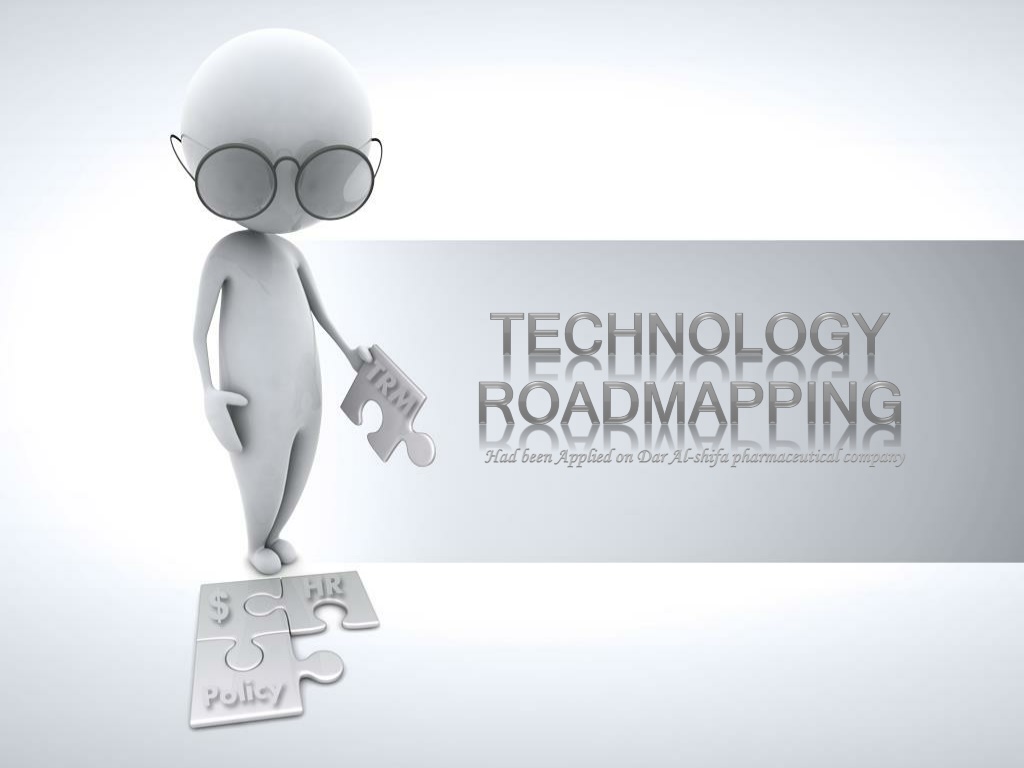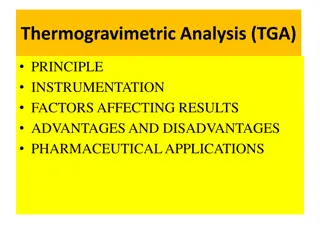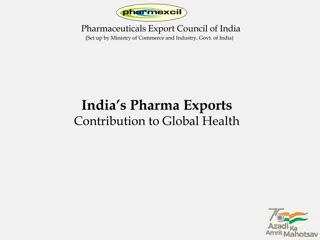Advances in Technology Roadmapping for Pharmaceutical Industries
Technology roadmapping (TRM) is a vital strategic tool for the pharmaceutical industry, allowing companies to align technology investments with market needs, foster innovation, and enhance competitiveness. This process, rooted in the semiconductor industry in the 1970s, has since evolved to help companies like Motorola and Vodafone succeed. By focusing on product portfolios and long-term planning, TRM enables firms to navigate rapidly changing markets and forge partnerships for sustainable success.
Download Presentation

Please find below an Image/Link to download the presentation.
The content on the website is provided AS IS for your information and personal use only. It may not be sold, licensed, or shared on other websites without obtaining consent from the author. Download presentation by click this link. If you encounter any issues during the download, it is possible that the publisher has removed the file from their server.
E N D
Presentation Transcript
Had been Applied on Dar Al Had been Applied on Dar Al- -shifa shifapharmaceutical company pharmaceutical company
DONE BY Hazar Ashour Noor Barham Rawand Najeeb Maysa Darawshe SUPERVISED BY Had been Applied on Dar Al Had been Applied on Dar Al- -shifa shifapharmaceutical company pharmaceutical company Dr. Husam Arman
INTRODUCTION INTRODUCTION The definition of new products is a difficult activity, which frequently ends in a stalemate: It must be don versus It is impossible to realize in such a short time frame . The root cause of this frustrating stalemate is most often the fact that we try to solve a problem in a much too limited scope. Roadmapping is a method to prevent these discussions by lifting the discussion to a wider scope: from single product to product portfolio and from a single generation of products to several generations in many years.
WHY TRM ... WHY TRM ...1 1. ? . ? TRMs are exceptional analytical and marketing tools with the capacity to chart future technological developments and help determine the strategic choices that companies need to make. Through this process, TRMs provide impetus for research and development, technological innovation and technology transfer.Technology roadmapping is essential for many reasons, in general: market directions, forecast Technology and markets are changing more and more rapidly. Industry needs to address today's pressing needs and tomorrow's market goals. Many solutions are beyond the ability of individual firms. Companies want and need new partnerships to support their own technology strategies. Common needs demand leveraged solutions.
WHY TRM ... WHY TRM ... 2 2.? .? It also can helps companies and R&D organizations to think strategically, decide intelligently and collaborate strongly to deliver the critical solutions they need to succeed in tomorrow's markets. It aims to enhance the competitiveness of industries, identifying and developing innovative technologies important for success in the highly competitive global market.
HISTORY OF TRM HISTORY OF TRM The first use for this process was in the semiconductor industry at 1970, which the purpose was aligning technology investments with market needs, and the technology companies that have become dependent upon are Motorola and Vodafone. Our chosen target sector to implement the project in was the pharmaceutical industries, since their economy grow significantly, relatively high investments, in addition to the technological development of such industries as it is one of the large and advanced industries in Palestine.
PROJECT OBJECTIVE PROJECT OBJECTIVE To raise the awareness about TRM and it s benefits. To evaluate current practice of TRM in pharmaceuitical palestinian company. Apply TRM in areal scenario.
TRM MODEL TRM MODEL General information were collected and recognized about technology road mapping by various academic papers such as; that for Sandia national laboratories' model, university of Cambridge s model and University of Nottingham s model Sandia national laboratories model This model describe a generic technology road mapping process that firstly starting with a generic process ,this generic process must speed up technology road mapping development, at the same time a generic model must be customized to help us to specify the most leverage multiple applications .
TRM MODEL TRM MODEL Sandia national laboratories model The process, which combines these two targets, can set the technology` gaps that have an existing, and specify which the basic technologies that most multiple applications depend on. Technology road mapping development in this model is implemented through groups of technology workers, who set their aims, targets, technologies areas and the standards for these areas and the alternatives available. their requirements, the
TRM MODEL TRM MODEL university of Cambridge s model Phaal`s model which is "start-up" process comprises a series of four facilitated workshops, that bring together various functions in the business, including technical and market. The four workshops are: Workshop1: Market This workshop aims to establish a set of prioritized market and business drivers for the future, reflecting external and internal factors. Performance dimension (e.g. speed, weight, reliability, and aesthetics) and market and business drivers must be identified in this workshop.
TRM MODEL TRM MODEL university of Cambridge s model Workshop2: Product This workshop aims to establish a set of 'product features' which could satisfy the drivers that identified in workshop 1. Workshop3: Technology This workshop aims to identify the technologies that can deliver the desired products. Worshop4: Road mapping Draws the marketing and technology stands together to produce the first road map. The format of the TRM is defined, in terms of time scales, levels, and product strategy.
TRM MODEL TRM MODEL University of Nottingham s model Nottingham`s methodology is to optimize the acquisition and alignment of technology, in order to enhance the achievement of strategic goals and minimize the risk of technology-based disruption. This methodology has been developed to provide particularly strong capabilities in the determination of key manufacturing technologies and in the assessment of proposed manufacturing technology projects. It consists six steps (requirement capture, benchmarking, technology watch, project generation, project evaluation, portfolio optimization), where the first three steps produced sets of technology`s requirements that based on company`s business drivers, products and competitive position and the last three steps enable the creation of assessments of R&D projects. This model was adopted in our project.
INFORMATION GATHERING INFORMATION GATHERING As the pharmaceutical sectors has been chosen, four pharmaceutical companies have been decided to implement the survey on and choose one company to apply TRM model on. These companies were (A,B,C&D), for confidentiality purposes their names were not mentioned. A small survey was developed to find out the perception from those companies on technology roadmapping and their relationship with product development performance.
INFORMATION GATHERING INFORMATION GATHERING The survey was divided into three sections;the first one was about the business strategy of the company. The second was about company markets and products and special information about them. The last one was about the technology used in the company and about the R&D department and its work. in addition to general information about those companies, such as; their investment, their employees, their department etc.
INFORMATION GATHERING INFORMATION GATHERING - - SURVEY SURVEY The results of the survey were: Market segment CompanyA: Palestinian market, Arab markets (Algeria, Yemen and United Arab Emirates), International markets (Eastern Europe, Kazakhstan, Uzbekistan and Russia). CompanyB: Palestinian local market, Export to overseas since 4-5 years (export to Algeria, Yemen and Jordan). CompanyC: Local market, Local Tenders, Exported to Russia and Europe. CompanyD: Local market.
PRODUCT DEV. PRODUCT DEV. PROCESS PROCESS The way of this is similar to all companies. Which is: Launched a new product by examine the market needs or when requested by a doctor from the company a particular product does not exist in the market is connecting with the senior traders and the question of the movement of this product in the last month, after an idea of sales for this category is an appropriate decision as to whether they need this product or not Then enters in the processes and make sure that after the administration of the need for market and their ability to obtain materials needed to produce this type is being introduced in R&D.
TECHNOLOGY STRATEGY TECHNOLOGY STRATEGY It was noticed that companies A&D are following the same way which is; monitoring and updating technology is done by using medias such that; internet, international magazine and by special persons who visited medical exhibitions. The selection of technology is done by a study of it from several aspects. Technology management is done without fixed steps; it is done randomly so there s software to do that. It has a R&C department which make their usual duties in addition to the management of this department.
TECHNOLOGY STRATEGY TECHNOLOGY STRATEGY Company B: monitoring and updating done randomly not periodically by using medias; internet greatly, there is an R&D department which make their usual duties but without managing it orderly. Company D: there s no monitoring and updating for technology and the selection of it based on finance greatly, no software, no R&D department but they done the duties of such department without any management.
RESEARCH AND DEVELOPMENT RESEARCH AND DEVELOPMENT Companies A,B&C : they have a special department to research and development. Where Company D has a simple department to research and development. Their R&D projects: Company A: Development of permanent and ongoing financial products, Monitoring the efficiency of medicine through time, On all research and studies necessary to bring new medicines to market, Attempts to answer customer inquiries and complaints. Company B: development of new generic products they don t have, monitoring the efficiency of medicine through time. Company C: Find new drugs equivalent to foreign drug, Solve the problems of drugs and development to remain within the specifications of recent global and There are currently research on herbal medicines to find a new plant components were not known. Company D: still producing their products.
SUMMERY SUMMERY Based on the result above; the status of these companies is extremely similar and doing the same thing, companies A and C are considered to be the best options of this project as their companies similar to the global ones relatively although there s no innovation. Company C was adopted in our project, which was Dar AL- Shifa pharmaceutical company.
DAR AL DAR AL- -SHIFA SHIFA CASE STUDY CASE STUDY The steps of Nottingham model was applied to Dar AL-Shifa' company. The steps are: Requirement capture. Benchmarking. Technology watch. Project generation. Project prioritization. Identification of resources.
REQUIREMENT CAPTURE REQUIREMENT CAPTURE The requirement capture started with list of business drivers identified by the company as important because different product groups or part/component families may be associated with different drivers MARKET MARKET PRODUCT PRODUCT technology technology R R&D D
MARKETING MARKETING PRODUCT FAMILY MARKET Simi-solid Market Tablet Market Market capsules Powder Market Fluids Market
MARKETING MARKETING Each of this market has weight (ranked) depend on important of market itself and the important of the product in this market to determine the three or four most important market as shown in the figure (this weight based on Dar AL-shifa company): Table 1: The weight of each market 3.5 tablet market Market capsules 2.5 Powder 1.5 Fluids 1.5 Simi-solid 1
PRODUCT FAMILY MARKET PRODUCT FAMILY MARKET this chart shows the percent of weight of each market in product family market 4 3.5 3 2.5 product family market 2 1.5 1 0.5 0 tablet market Market capsules Powder Fluids Simi-solid
PRODUCT PRODUCT Anti Anti- -biotic biotic GI treatment GI treatment tablet market tablet market Anti Anti- -inflammatory inflammatory Anti Anti- -diary diary PRODUCT PRODUCT Anti Anti- -biotic biotic Hyper tension Hyper tension market Capsules market Capsules Diabetes Diabetes
????????????? ????????????? Products that will be launch in these markets in future this based on the Dar AL-shifa company's valuation of these products is: In Grain market: Prostate Capsules In market Capsules: Hyper-tension Anti-biotic The importance of each of these products in both markets based on ranked of the Dar AL-shifa companies as the following:
MARKET CAPSULES MARKET CAPSULES Anti-biotic. 70% 80% 70% GI treatment 20% 60% 50% 40% Anti- 5% 30% inflammatory 20% 10% 0% Anti-diary 5%
TABLET MARKET TABLET MARKET Anti-biotic 70% 80% 70% 60% Hyper tension 10% 50% 40% 30% Diabetes 20% 20% 10% 0% Diabetes Hyper tension Anti-biotic
TECHNOLOGY TECHNOLOGY Technology Market Capsules and tablet market have Anti-biotic product, which needed contributing technologies used to manufacture. Technology Used for Anti-biotic product in Market Capsules : TECHNOLOGY TECHNOLOGY ANT ANT- -BIOTIC BIOTIC Final mix with Final mix with lubrication lubrication Packaging Packaging Weighting Weighting Granulation Granulation Draying Draying Capsule filling Capsule filling
TECHNOLOGY TECHNOLOGY Technology Used for Anti-biotic product in tablet market: TECHNOLOG TECHNOLOG Y Y ANT ANT- -BIOTIC BIOTIC Compressio Compressio n n Plastering or Plastering or gar filling gar filling coating coating Weighting Weighting Granulation Granulation Draying Draying Final mix Final mix
BENCHMARKING BENCHMARKING The contributing technologies could be ranked by the dar-Alshifaa company s as important Moreover, identified the highest weightings technology used in each of the products, to plot this technology and to determine the appropriate technology depending on where it and its competitors in the market (Based on this level): Base. Must have relevant base technologies in order to operate; base technologies are widely exploited by competitors and are typically of little competitive impact. Key. Key technologies are established product differentiators. They are well embodied in products and processes, their competitive impact is high. Pacing. Probable future differentiator technologies, typically under experimentation by one or more competitors, competitive impact likely to be high. Emerging. Emerging technologies are in an early research state, possibly emerging in other industries. Competitive impact is unknown, but promising need to follow developments.
MOST IMPORTANT MOST IMPORTANT Most important technology has highest weightings: Drying (T1) Plastering (T2) Capsule filling (T3) Final mix (T4) Blistering new machine (T5) Emerging Pacing T5 T3 Key T2 T4 Base NowT1 Lag Led
TECHNOLOGY WATCH TECHNOLOGY WATCH Technology watch its diagram that presents the desired technology to produce new products, develop current products or develop production lines through a specific time (in this case for 5 years). This diagram describes the new technologies to be invested by. Now Dar- Al shifa` company is working on merging the two lines (packaging, plastering) in one production line (packaging +plastering). There is an underway Research and development project on Granulation and capacity technology to be considered after three years, sponsor filtration after five years. Packaging +plastering granulation + capacity sponsol filtration Current Now (2011) 2013 after 5year (2016)
RESULTS AND ANALYSIS RESULTS AND ANALYSIS As noted in the benchmarking, the company's level of technology is considered as good according to the local competitors, this is due to some barriers, which the most important one is the high capital investment. This company can apply acquisition integrated policy with other global company that has technologies in pacing level so, Dar el- shefa` company will benefit from these technologies to produce locally products with globally advantages. The integration with globally company will increase the quality and demand for the product, which affect the company`s market share
END THANKS FOR LISTENING THANKS FOR LISTENING END























